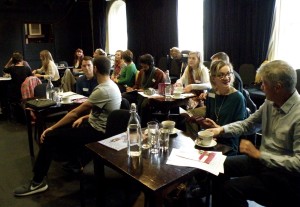The Church Urban Fund (CUF) and The Department for Communities and Local Government DCLG have launched a £1.5 million grants scheme aimed at helping diverse communities get together and build understanding through joint projects, offering opportunities if you know of a heritage related project that could benefit from the Near Neighbours programme?
The Church Urban Fund writes:
The government today announced that £1.5 million has been awarded to the ground-breaking Near Neighbours programme to build relationships between different communities to address hate, fear, and the voices of division. The Near Neighbours programme has received a third round of funding after two successful phases of funds from the government have been used to transform communities and promote the view that we can live well together.
The Near Neighbours grants fund has awarded seed capital worth £3.66m to over 1,120 projects. These projects have impacted the lives of 941,000 people and 71% of projects have continued to run after the initial seed capital was spent. All Near Neighbours projects are designed to change hearts and minds by bringing together different communities within a neighbourhood so that they can work together on issues of shared concern and common values.
In tackling voices of hate, projects work across a variety of pressing social needs and issues including employment skills, environmental work, homelessness, and healthy eating, with 53% of projects providing new skills to the unemployed and 33% offering important social support to refugees. The latest wave of funding will be used to continue the work in communities by providing further support and grants.
One programme participant spoke to the effectiveness of Near Neighbours, ‘You cannot have a more peaceful project in the country. Programmes like this will change people. It is the biggest investment for the future. Every community where people are sitting down and knitting together, eating together, singing together will not have tension in it.’
The Archbishop of Canterbury, Justin Welby, said: ‘I am delighted that the government has provided Near Neighbours with the funding to start its third phase of work. The innovative, collaborative and inspiring work of Near Neighbours has enabled diverse local communities across the country to work and live together effectively, but more importantly, it has enabled community relationships and friendships to blossom. As Christians we have been celebrating Easter with its message of hope and reconciliation for all people. We are committed to working with others of faith or no faith to see the transformation and restoration of our local communities. It is this vitality that makes me excited for the future of Near Neighbours.’
Communities Minister Baroness Williams said: ‘Local people are best placed to know how they want their neighbourhoods to improve and Near Neighbours has a great track record in encouraging individuals from different backgrounds, faiths and cultures to come together on the issues and concerns that are most important to them. This new funding is a great boost to the important work Near Neighbours does to build stronger local ties, mutual understanding and respect to make our neighbourhoods even better places to live.’
The Near Neighbours programme is administered by the Church Urban Fund and CUF Executive Chair and Near Neighbours trustee, Paul Hackwood commented ‘Near Neighbours has created a new way of doing community in England that sees neighbours stand up to voices of hate and insist on a new narrative that rejects violence in favour of peace. I’m excited to see that work continue for a further year as we reach further into England’s communities.’
Rabbi Natan Levy, an advisor to the Near Neighbours programme and commented: ‘The Jewish community warmly welcomes the continuation of the Near Neighbours Programme. Minority groups, like our own, can often turn inward in this age of increasing tension, and programmes that gently nudge us to engage with people, cultures and faiths that are different than us, are simply vital. Near Neigbhours builds robust bridges where there was once only chasms of mistrust. Near Neigbours programmes are the ‘still small voice’ of local change, offering tremendous seeds of hope. I’ve had the opportunity to work first hand with numerous Near Neighbours projects, from interfaith young women learning computer coding with Twitter engineers, to transformative youth group workshops that tackle the hard issues, Near Neighbours is a blessing to our Jewish community, and the catalyst towards a safer, kinder, and profoundly more enriched United Kingdom.’
Chair of Near Neighbours trustees, Baroness Eaton said: ‘Near Neighbours is doing an excellent job of reaching deep into the heart of communities and this funding is going to be invaluable in reaching more people and enabling them to take action together in their communities.’
Dilwar Hussein is a Near Neighbours advisor and commented: ‘I’m very happy to hear that the Near Neighbours programme has been awarded a third round of funding. This work is vital in bringing people together at a time of extreme anxiety, to bridge divides and challenge narratives of hatred and division. Near Neighbours manages to reach right into the heart of communities, where people are working at the coal face of relationship building. I look forward to the programme expanding and reaching even more people’.
View the press release
Find out more about Near Neighbours and the funding criteria


